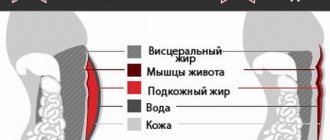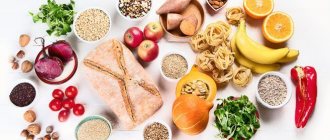Fact #1: Fat comes in different colors.
If you ask what color is the fat in our body, most likely, many will think that human fat is white or yellow. This is true. Most of the adipose tissue is white and is located under the skin on our abdomen and thighs.
But there is also so-called “brown fat”. Babies are born with a lot of “brown fat,” which helps them maintain their body temperature. With age, the amount of “brown fat” decreases sharply.
In 2012, the University of Sherbrooke published a study showing that brown fat keeps our bodies warm by using white fat as fuel.
Fact #2: Not every adult has brown fat.
Over the course of a year, 50 grams of “brown fat” burns up to 4.5 kg of white fat. In adults, the amount of “brown fat” decreases sharply by the age of 40–50, which is one of the reasons for weight gain in older age. People who have problems with excess weight usually have a lack of “brown fat”.
Photo: Depositphotos
Currently, scientific research is being conducted to obtain substances that can activate or replace “brown fat” in the human body. Obtaining such a substance will be a real revolution in the theory of weight loss.
What foods contain fats: list
Lipids are part of the cells of animal and plant organisms, therefore they are found in all natural foods. Foods of animal origin usually exceed plant foods in terms of fat concentration, however, there are exceptions. Fatty foods include products with a content level of more than 10 grams per 0.1 kg of product.
This division is relative. Milk with a moisture content of 88% contains 3.5% fat. In terms of dry matter, the lipid concentration is 29%.
High fat foods
Among the foods containing a lot of fat are the following:
| Animal products | Plant products |
| Farm animal meat: pork, beef, lamb, duck, goose, chicken | Vegetable oils |
| Fatty fish - mackerel, herring, salmon, flounder, carp | Nuts: almonds, hazelnuts, peanuts, pistachios |
| Milk processing products - sour cream, butter, cheeses, full-fat cottage cheese | Oilseeds: flax, soybean, sunflower, |
| Meat processing products: lard, carbonate, loin, sausage, etc. | Fatty fruits: avocado, olives |
| Chicken eggs, powdered or condensed milk | Chocolate, potato chips, cakes |
Low fat foods
Low fat foods include the following:
| Animal products | Plant products |
| Milk processing products: low-fat cottage cheese, kefir, yogurt, cheeses | Cereals, pasta |
| Low-fat fish: pollock, hake, pike, pike perch, seafood | Vegetables fruits |
| Meat and its processed products: broiler chickens slaughtered at 35 days, chicken and turkey breasts, veal, lamb | Oilseeds: flax, soybean, sunflower, |
Fact #5: Body fat is not always dangerous.
It has been scientifically proven that excess adipose tissue is a source of systemic inflammation in the body. In the human body, fat contains a large number of macrophages - immune cells that, in response to external or internal stimuli, release pro-inflammatory substances - prostaglandins - into the blood. And the adipose tissue itself constantly destroys fat, releasing fat peroxidation products, which has a harmful effect on the body.
Fortunately, there are people whose fat is inert, that is, it not only does not release inflammatory substances in response to irritation, but also contains macrophages, which, on the contrary, release anti-inflammatory substances. For these lucky people, being overweight is a purely cosmetic problem; they are metabolically absolutely healthy, have normal cholesterol, and no hypertension or insulin resistance (prediabetes).
Currently, in the scientific community it is common to talk about two types of obesity: metabolically healthy (1) and leading to the development of diseases (2). But the issue of the transition of “healthy” obesity to “metabolically dangerous” remains on the agenda of scientists.
Photo: Depositphotos
Why do we need fats?
You might be surprised to learn that not all fats are harmful to the body. There are also those that are vital for him. Fats help form cell membranes, connective tissues, and phospholipids. They help you lose weight, maintain weight and build muscle mass.
The daily intake of fat is 1 g per 1 kg of body weight.
A deficiency of “correct” fats provokes hormonal disorders, which are accompanied by a decrease in estrogen levels in the body, disruption of the menstrual cycle, etc. And it is clear that you need to give preference to this type of fat.
Fact No. 7: Sleep provides the necessary balance of body fat.
It has been scientifically proven that lack of sleep leads to obesity. People who don't get enough sleep at night tend to be overweight.
Lack of adequate sleep leads to disruption of adipose tissue. Fat cells become less sensitive to insulin, resulting in high blood sugar levels. In the future, this can lead to serious diseases such as diabetes, heart attack and stroke.
We must remember that such adverse consequences await even people who are not overweight, but neglect night sleep.
Healthy fats, without which it is impossible to be healthy and lose weight
The opinion that fats are harmful to health and figure has long been established in people's minds. Therefore, many try to avoid foods that contain these substances. However, in reality the situation is completely different. Fats are divided into several types. Certain types must be on the menu even during a diet. They are necessary for the body to maintain the normal functioning of major organs and systems.
Types of edible fats
The diet of any person must be balanced - contain the proper amount of fats, proteins and carbohydrates. Therefore, it is impossible to completely exclude any element from the power system.
All dietary fats are divided into 4 types:
- Saturated;
- Polyunsaturated;
- Monounsaturated;
- Trans fats.
Each group has an individual effect, so they must be considered separately.
Saturated fats
Saturated fats are organic compounds that consist of single carbon bonds. For a long time it was believed that their consumption should be strictly limited, because they increase the level of “bad” cholesterol in the blood and provoke the development of heart and vascular diseases.
But the latest research has shown that there is no connection between the occurrence of these ailments and these substances. Naturally obtained saturated fats have no negative health effects. But you need to be able to distinguish useful from harmful. For example, fat remaining after frying foods cannot be eaten.
When consumed in moderation, they contribute to:
- Sufficient production of hormones of the reproductive system;
- Lauric acid increases the level of “good” cholesterol;
- When digested, they are transformed into monounsaturated oleic acid, which is necessary for regulating heat exchange.
If you simultaneously control the amount of carbohydrates (4 grams per 1 kg), then they will not lead to excess weight gain. They have a solid structure. To melt them, a high temperature is needed, so the body spends a lot of energy on their processing. The sources of these compounds are lard
, butter, coconut and palm oil.
Monounsaturated fats
These substances, containing monounsaturated fatty acids, should be regularly included in the menu. They reduce the level of “bad” cholesterol, prevent the formation of atherosclerotic plaques, and are rich in vitamins and minerals.
This group includes palmitic and oleic acids. These are substances that help you lose weight
. They do not accumulate in the body in the form of a fatty layer, but contribute to the normalization of lipid metabolism. They are rich in nuts, sunflower and olive oil, and avocados.
Polyunsaturated fats
This variety is essential, meaning the body cannot synthesize them on its own. Therefore, you need to ensure that foods containing these compounds are present in your diet on a regular basis. Polyunsaturated fatty acids are divided into 2 types - Omega-3 and Omega-6. They are building materials for body cells and support the health of the heart muscle. .
They can be found in sea fish, flaxseed and hemp oil, and walnuts.
Trans fats
Such compounds do not have any positive properties. In product formulations, they are often referred to as “partially hydrogenated oils.” Most of them are obtained artificially. When used frequently, they produce the following effect:
- They increase the amount of “bad” cholesterol and reduce the level of “good” cholesterol, which is necessary to cleanse blood vessels;
- They increase the risk of heart disease and stroke, and the development of diabetes.
These substances are usually found in processed foods, deep-fried foods, chips, margarine, mayonnaise, and ketchup. They are added based on considerations such as:
- Long shelf life;
- Low cost;
- Good taste characteristics;
- Can be used for frying for a long time.
Their presence in food should be avoided.
Daily value for humans
Research shows that fats should be consumed daily through food. The optimal rate can be calculated using the following formula - 1 g per 1 kg of weight. An adult man needs about 80 grams, a woman – 60-70 grams. But you need to make sure that the products contain healthy fats and not harmful ones.
The indicated dosage may vary if a person consumes many calories per day. For people leading an active lifestyle and playing sports, you need to increase your intake by about 30 grams. All fats will be converted into energy, which gives the body additional strength.
Food sources
To properly plan your diet, you need to know which foods provide saturated and healthy fats. They begin to be consumed gradually, starting from 2-3 times a week. At the same time, the amount of food rich in carbohydrates must be reduced.
List of foods rich in healthy fats:
- Olive oil is high in essential fats and saturates the body with other valuable elements: antioxidants, polyphenols and vitamins;
- Avocado – when systematically included in the diet, this exotic fruit normalizes the water-salt balance, receives a daily dose of potassium, cleanses the blood of “bad” cholesterol, and strengthens the immune system. A medium-sized avocado contains 22 grams of healthy fat, most of which is monounsaturated compounds;
- Nuts are capable of suppressing feelings of hunger for a long time, but due to their high energy value they cannot be abused;
- Fatty fish are mainly marine species, which include trout, mackerel, salmon, herring, and sardines. They are a source of Omega-3 fatty acids and nutritious proteins. Systematic consumption is an excellent prevention of heart and vascular diseases, depression, dementia and other widespread ailments. This product can be replaced with fish oil;
- Dairy products - yoghurts and cheeses. The first type of product is rich in nutrients and live bacteria, which have a positive effect on the digestive process. It provides the body with a sufficient dose of calcium and protein. But don't buy yogurt that contains a lot of sugar. It's better to learn how to do it yourself at home.
Cheese is also rich in calcium, protein, vitamins and minerals. The combination of protein and fat gives you a feeling of fullness for a long time, which helps you control the amount of food you consume;
- Eggs - There has long been debate about the advisability of consuming them, since they contain a lot of cholesterol. But scientists have proven that they do not lead to an increase in the amount of this compound in the blood. Fresh homemade eggs contain, in addition to fats, a whole range of substances necessary for health. Therefore, you should not exclude them from your diet.
Proper nutrition is the key to good health. Therefore, it is necessary to carefully approach the preparation of the daily menu and ensure that the products provide the body with valuable elements.











